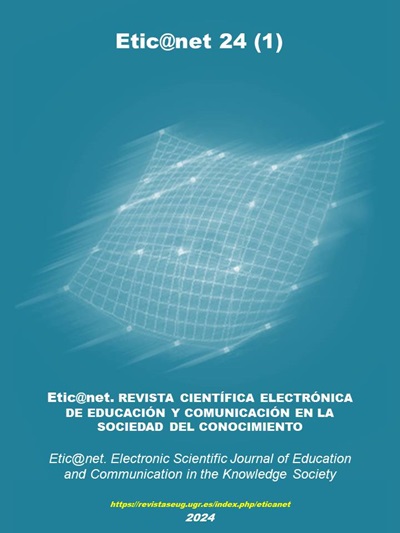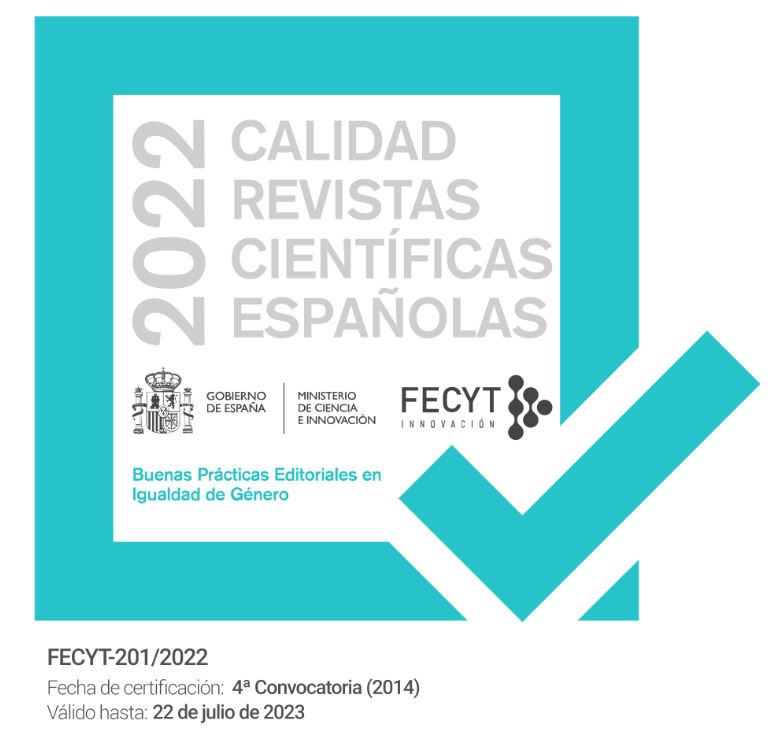The role of information and communication technologies in foreign language learning under the pandemic. Professors' perspective
DOI:
https://doi.org/10.30827/eticanet.v24i1.28837Keywords:
flipped classroom, information technology, online learning, pandemics.Abstract
This article researches the communicational barriers and teacher-student interactional processes evidenced in the use of information and communication technologies for teaching modern languages, by professors at a university in Bogota - Colombia, when migrating from face-to-face classes to telepresence in the context of the COVID 19 pandemic, also identifies the benefits, effects, challenges and opportunities brought by this implementation. The purpose of this study is to propose recommendations for the improvement of educational practices in the telepresence modality. Data collection was carried out through a cross-sectional, descriptive and explanatory study, complemented with the implementation of a qualitative approach technique. It is concluded that the use of web pages, mobile devices and ICTs were well accepted as tools used by teachers despite the difficulties encountered in student interaction and learning, facilitating virtual education as positive value complements, and favoring teaching.
Downloads
References
Aguerrondo, I., Grinberg, S., Lugo, M. T. Marchesi, A. y Martín – Ortega, Elena. (2006). La Integración de las Tecnologías de la Información y la Comunicación en los Sistemas Educativos. Ministerio de Educación, Ciencia y Tecnología. Programa de Mejoramiento del Sistema Educativo
https://unesdoc.unesco.org/ark:/48223/pf0000150785.locale=es
Altas, E. A., & Mede, E. (2021). The impact of flipped classroom approach on the writing achievement and self-regulated learning of pre-service English teachers. Turkish online journal of distance education, 22(1), 66–88. https://doi.org/10.17718/tojde.849885
Apolo, D., Rodríguez-Lozano, M. N., Bueno de Santiago, A., y Solano-Saldaña, J. (2018). Uso de internet con fines educativos: aproximaciones hacia estudiantes universitarios en formación inicial docente. En F. J. Herrero.
Arras-Vota, A. M., Bordas-Beltrán, J. L., Porras-Flores, D. A., y Diez, M. del C. G. (2021). Evolución en el uso de las tecnologías de la información y comunicación (TIC) y competencias de los docentes de la Universidad Autónoma de Chihuahua (México), durante la pandemia. Formación Universitaria, 14(6), 183–192. https://doi.org/10.4067/s0718-50062021000600183
Arriagada, P. (2020). Pandemia Covid-19: educación a distancia. O las distancias en la educación. Revista Internacional de Educación para la Justicia Social, 9, 1–3.
Brown, E., Gray, R., Lo Monaco, S., O’Donoghue, B., Nelson, B., Thompson, A., Francey, S., & McGorry, P. (2020). The potential impact of COVID-19 on psychosis: A rapid review of contemporary epidemic and pandemic research. Schizophrenia Research. 222, 79 - 87 https://doi.org/10.1016/j.schres.2020.05.005
Bursa, S., & Cengelci - Kose, T. (2020). The effect of flipped classroom practices on students’ academic achievement and responsibility levels in social studies course. Turkish Online Journal of Distance Education, 21(4), 143-159. https://doi.org/10.17718/tojde.803390
Buxarrais, M. R. (2016). Redes sociales y educación. Education in the Knowledge Society (EKS), 17(2), 15–20. https://doi.org/10.14201/eks20161721520
Cervantes, E., y Gutiérrez, P. (2020). Resistir la Covid-19. Intersecciones en la Educación de Ciudad Juárez. Revista Internacional de Educación para la Justicia Social, 9(3), 1–23. https://doi.org/10.15366/riejs2020.9.3.001
Eraslan-Yalcin, M., & Kutlu, B. (2019). Examination of students’ acceptance of and intention to use learning management systems using extended TAM. British Journal of Educational Technology: Journal of the Council for Educational Technology, 50(5), 2414–2432. https://doi.org/10.1111/bjet.12798
Harley, J. M., Liu, Y., Ahn, B., Lajoie, S. P., & Grace, A. P. (2020). Examining physiological and self‐report indicators of empathy during learners’ interaction with a queer history app. British Journal of Educational Technology: Journal of the Council for Educational Technology, 51(6), 1921–1938. https://doi.org/10.1111/bjet.13019
Howlett, G., & Waemusa, Z. (2018). Digital Native/Digital Immigrant Divide: EFL Teachers’ Mobile Device Experiences and Practice. Contemporary Educational Technology, 9(4), 374-389. https://doi.org/10.30935/cet.471007
López-Campuzano, C., y Estrada-Orrego, V. (2022). Desconexión entre actores: percepciones del uso de tecnologías educativas durante la pandemia por COVID-19. Trilogía Ciencia Tecnología Sociedad, 14(26), e2213. https://doi.org/10.22430/21457778.2213
Moya-López, M. (2013). De las TICs a las TACs: la importancia de crear contenidos educativos digitales. Revista DIM Didáctica, Innovación y Multimedia, 27, 1699–3748.
Muñoz, A. y García. V. (2002). Tecnología educativa: características y evolución de una disciplina. Revista Educación y Pedagogía, 33, 65–87. https://revistas.udea.edu.co/index.php/revistaeyp/article/view/5572
Parra-Rodríguez, G. A. (2016). Educación y Tecnología en Colombia. Los retos que enfrenta el país en la formación de las nuevas generaciones. Revista Javeriana, 152(824), 60–65. https://www.javeriana.edu.co/documents/16089/4952566/noticiascontenido63.pdf
Prieto-Díaz, V., Quiñones La Rosa, I., Ramírez Durán, G., Fuentes Gil, Z., Labrada Pavón, T., Pérez Hechavarría, O., y Montero Valdés, M. (2011).
Impacto de las tecnologías de la información y las comunicaciones en la educación y nuevos paradigmas del enfoque educativo. Educación Médica Superior, 25(1), 95-102. http://scielo.sld.cu/scielo.php?script=sci_arttext&pid=S0864-21412011000100009&lng=es&tlng=es.
Rivero-Cárdenas, I., Gómez Zermeño, M., y Abrego Tijerina, F. (2013). Tecnologías educativas y estrategias didácticas: criterios de selección. Educación Y Tecnologí¬a, (3), 190 - 206. http://revistas.umce.cl/index.php/edytec/article/view/134
Rodríguez-Calderón de la Barca, D. (2021). Condiciones, Voces y Percepciones de Jóvenes de la UPN durante la Pandemia de COVID – 19. Revista Panamericana de Pedagogía, (33). https://doi.org/10.21555/rpp.v33i33.2407
Roque, V., Raposo, R., Nina de Morais, N. S., y Roque, F. (2021). Enseñanza y Aprendizaje en Línea durante la Pandemia de COVID-19 - El Caso de la Educación Superior Pública Portuguesa. Revista Prisma Social, 35(1989-3469), 221 -248.
Rueda-Ortiz, R., y Franco-Avellaneda, M. (2018). Políticas educativas de TIC en Colombia: entre la inclusión digital y formas de resistencia-transformación social. Pedagogía y saberes, 48. https://doi.org/10.17227/pys.num48-7370
Ruiz, G. R. (2020). Marcas de la Pandemia: El Derecho a la Educación Afectado. Revista Internacional de Educación para la Justicia Social (RIEJS), 9(3), 45–59. https://doi.org/10.15366/riejs2020.9.3.003
Salas-Rueda, R. A., Castañeda-Martínez, R., Ramírez -Ortega, J., y Garcés-Madrigal, A. (2021). Opinión de los educadores sobre la tecnología y las plataformas web durante la pandemia Covid-19. Revista gestión de las personas y tecnología, 14(40), 17. https://doi.org/10.35588/gpt.v14i40.4860
Salas-Rueda, R. A., De-La-Cruz-Martínez, G., Alvarado-Zamorano, C. y Gamboa- Rodríguez, F. (2020). Dispositivos móviles y Muro colaborativo: ¿medios de comunicación para innovar el proceso de enseñanza-aprendizaje sobre las ciencias sociales? Revista Meta: Avaliação, 12(36), 601-624. doi: http://dx.doi.org/10.22347/2175-2753v12i36.2626
Salas-Rueda, R. A. (2020). Use of the flipped classroom to design creative and active activities in the field of computer science. Creativity studies, 13(1), 136–151. https://doi.org/10.3846/cs.2020.10336
Salas-Rueda, R. A. (2019). Construction and evaluation of a web application for the educational process on Normal Distribution considering the science of data and machine learning. Research in Learning Technology, 27, 1-24. https://doi.org/10.25304/rlt.v27.2085
Soler-Pellicer, Y., y Lezcano - Brito, M. G. (2009). Consideraciones sobre la tecnología educativa en el proceso de enseñanza-aprendizaje. Una experiencia en la asignatura Estructura de Datos. Revista Iberoamericana de Educación, 49(2), 1–9. https://doi.org/10.35362/rie4922108
Stratton, E., Chitiyo, G., Mathende, A. M., & Davis, K. M. (2020). Evaluating Flipped Versus Face-to-face Classrooms in Middle School on Science Achievement and Student Perceptions. Contemporary Educational Technology, 11(1), 131-142. https://doi.org/10.30935/cet.646888
Torres-Cañizález, P. C., y Cobo-Beltrán, J. K. (2017). Tecnología educativa y su papel en el logro de los fines de la educación. Educere, 21(68), 31 – 40. http://www.saber.ula.ve/handle/123456789/43705
Yuen, A. H. K., Cheng, M., & Chan, F. H. F. (2019). Student satisfaction with learning management systems: A growth model of belief and use. British Journal of Educational Technology: Journal of the Council for Educational Technology, 50(5), 2520–2535. https://doi.org/10.1111/bjet.12830
Yuen, E. K., Goetter, E. M., Stasio, M. J., Ash, P., Mansour, B., McNally, E., Sanchez, M., Hobar, E., Forte, S., Zulaica, K., & Watkins, J. (2019). A pilot of acceptance and commitment therapy for public speaking anxiety delivered with group videoconferencing and virtual reality exposure. Journal of Contextual Behavioral Science, 12, 47–54. https://doi.org/10.1016/j.jcbs.2019.01.006
Ziyad, H. (2016). Technology-mediated ELT Writing: Acceptance and Engagement in an Online Moodle Course. Contemporary Educational Technology, 7(4), 314-330. https://doi.org/10.30935/cedtech/6179
Downloads
Published
Issue
Section
License
The authors who publish in this journal agree to the following terms: The authors retain the copyright and grant the journal the right to be the first publication of the work as well as licensed under a Creative Commons Attribution License that allows others to share the work with an acknowledgment of the authorship of the work and the initial publication in this magazine. Authors are allowed and encouraged to disseminate their work electronically (for example, in institutional repositories or on their own website) before and during the submission process, as it may lead to productive exchanges as well as further citation. Earliest and greatest of published works (See The Effect of Open Access).













